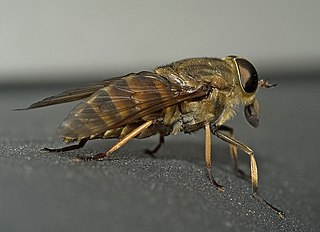
The Brachyceran infraorder Tabanomorpha is a small group that consists primarily of two large families, the Tabanidae and Rhagionidae, and an assortment of very small affiliated families, most of which have been included within the Rhagionidae.

The Brachyceran family Vermileonidae is a small family of uncertain affinities and unusual biology. It includes fewer than 80 described species, most of them rare and with restricted distribution, in 11 genera. Historically the vermileonids had been regarded as belonging to the family Rhagionidae, possibly in a subfamily Vermileoninae. Their biology and morphology are so markedly distinct from the main Rhagionidae sensu stricto however, that the placement as a separate family has been widely accepted.

Rhagionidae or snipe flies are a small family of flies. They get their name from the similarity of their often prominent proboscis that looks like the beak of a snipe.

Rhagio is a worldwide genus of predatory snipe flies. Several species in this genus are referred to as downlooker or down-looker flies because they sometimes perch on tree trunks in a head-down position. There are approximately 170 species. They can be distinguished from other rhagionids by the open anal cell on the wings and the lack of a kidney-shaped arista.

Symphoromyia is a genus of predatory snipe flies. Unusually for Rhagionids, some species of Symphoromyia are known to feed on mammal blood, including human blood. Symphoromyia species are stout bodied flies from 4.5 to 9 mm and with a black, grey or gold thorax, and the abdomen is coloured grey, black, or both black and yellow, black terminating with yellow, to completely yellow. The wings are hyaline or lightly infuscate.

Bolbomyia is a genus of snipe flies, and the sole genus in the family Bolbomyiidae; until 2010, it was placed in the family Rhagionidae. They are a small 2 to 3.5 mm, brown or black in color, with lightly infuscate (darkened) wings. They are restricted to the north temperate region of North America and Russian Far East (Kamchatka).
Alloleptis is a genus of snipe fly of the family Rhagionidae. It is a small fly of about 4 mm and only known from Sulawesi. It currently contains only one species, Alloleptis tersus.
Arthroceras is a genus of snipe fly of the family Rhagionidae. Arthroceras are mid-sized to large 4.5 to 13 millimetres, black, grey, or yellowish-colored flies that have a fairly long, tapering antenna consisting of 5–8 flagellomeres. Within Rhagonidae, the genus is sometimes(?) placed in the subfamily Arthrocerinae, in which it is the only genus.
Arthroteles is a genus of snipe fly of the family Rhagionidae. Species of Arthroteles are moderately sized, from 5 to 7.5 mm. They are gray to dark gray in colour. Their antenna bears seven to eight tapering flagellomeres, the first much larger than all others.

Rhagio mystaceus, also known as the down-looker fly, downlooker snipefly and common snipe fly, is a species of fly from the family Rhagionidae.
Chrysopilus velutinus is a species of snipe fly in the family Rhagionidae.

Rhagio punctipennis, the lesser variegated snipe fly, is a species of snipe flies in the family Rhagionidae.

Chrysopilus fasciatus is a species of snipe fly in the family Rhagionidae.
Chrysopilus griffithi is a species of snipe fly in the family Rhagionidae.
Chrysopilus pilosus is a species of snipe fly in the family Rhagionidae.
Chrysopilus andersoni is a species of snipe fly in the family Rhagionidae.

Chrysopilus basilaris is a species of snipe fly in the family Rhagionidae.
Chrysopilus proximus is a species of snipe fly in the family Rhagionidae.

Chrysopilus connexus is a species of snipe fly in the family Rhagionidae.
Chrysopilus ater is a species of snipe fly in the family Rhagionidae













